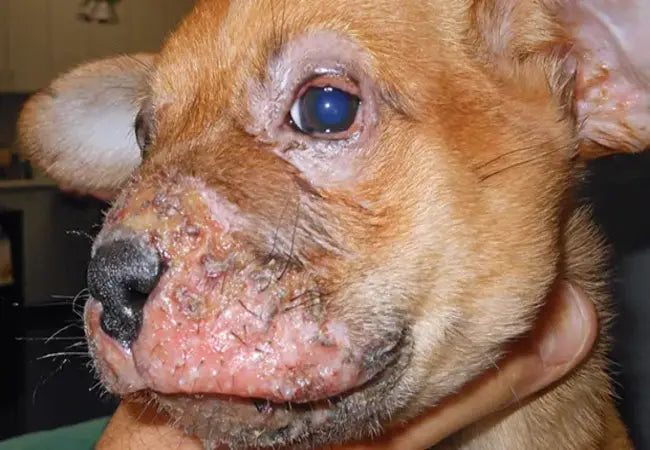Vet’s 2025 Guide to Canine Puppy Strangles 🩺 Diagnosis, Treatment & Recovery

In this article
Vet’s 2025 Guide to Canine Puppy Strangles 🩺 Diagnosis, Treatment & Recovery
By Dr. Duncan Houston BVSc
💡 What Is Puppy Strangles?
Puppy strangles—also called juvenile cellulitis or sterile granulomatous dermatitis and lymphadenitis—is a rare, immune-mediated condition seen in young dogs (<6 months). It causes sudden facial and muzzle swelling, painful pustules, and enlarged lymph nodes.
🧬 Causes & Risk Factors
- Idiopathic immune dysfunction: The puppy’s immune system mistakenly attacks skin tissues.
- Hereditary predisposition: Seen more often in breeds like Golden Retrievers, Dachshunds, Gordon Setters, Beagles, Labs, Boxers, etc..
- Age: Usually affects puppies from 3 weeks to 6 months old, though rare adult cases occur.
⚠️ Key Clinical Signs
- Facial swelling: Typically both sides of the muzzle, around eyes, ears; looks like mumps.
- Pustules & crusts: Painful papules that ooze, rupture, crust—especially on face, ears, sometimes paws, genitals.
- Submandibular lymphadenopathy: Enlarged, often tender lymph nodes under the jaw; may rupture and drain.
- Systemic signs: Fever (pyrexia), lethargy, decreased appetite. Some puppies have joint pain or lameness (sterile arthritis).
- Pain not itch: Lesions are painful and swollen, not typically itchy unless secondarily infected.
🧪 Diagnostic Work-Up
- Clinical suspicion: Sudden facial swelling in young puppies—rule out insect bites, allergies.
- Skin cytology: Reveals sterile pyogranulomatous inflammation; negative cultures unless infected.
- Skin scrapings/cultures: Rule out mites, fungi, and bacterial pyoderma.
- Skin biopsy: Confirms pyogranulomatous dermatitis and lymphadenitis with no pathogens.
- Bloodwork: May show elevated WBC, mild anemia, but used mainly to assess general health.
🩺 Treatment Protocol
1. High‑Dose Steroids
- First-line: Prednisone/prednisolone at ~2 mg/kg once daily until lesions resolve (2–4 weeks), then taper.
- Alternative: Dexamethasone (0.2 mg/kg) if steroids are not tolerated; cyclosporine may help in refractory cases.
2. Antibiotics for Secondary Infection
Although sterile initially, pustules may become infected:
- Commonly use cephalexin or amoxicillin–clavulanate to cover secondary pyoderma.
3. Supportive & Topical Care
- Clean lesions gently with chlorhexidine or Burow’s solution to soothe and reduce infection risk.
- Offer pain relief (acepromazine or safe analgesics) as needed.
- Use medicated shampoos or ointments under vet direction.
📅 Recovery & Monitoring
- Improvement often seen within days of starting steroids; full resolution in 10–14 days, occasionally up to 4–8 weeks.
- Taper steroids gradually—abrupt stop risks relapse.
- Monitor lesion healing, energy, appetite, body weight.
- Check for side effects: polyuria, polydipsia, excessive appetite due to steroids.
- Relapse is uncommon with proper dosing; scarring or hair loss may be permanent if delays occur.
🏡 Ask A Vet At‑Home Support
- Log lesion photos, swelling, pustules, appetite and energy daily.
- Medication reminders for steroids, antibiotics, and pain meds.
- Alerts for fever, appetite changes, lethargy, or lesion deterioration.
- Guidelines for lesion cleaning and pain relief.
- Follow-up scheduling: exam, steroid taper plan, potential skin biopsy revisit.
🔍 Key Takeaways
- Puppy strangles is rare but treatable—recognize sudden swelling in young pups promptly.
- Diagnosis via cytology/biopsy; rule out infection or parasites.
- High-dose steroids are crucial, paired with antibiotics only if needed.
- Recovery is good with early intervention; delayed treatment risks scarring.
- Ask A Vet streamlines at-home management: tracking, reminders, and early relapse alerting.
🩺 Conclusion ❤️
Puppy strangles can be frightening, but with accurate diagnosis and early steroid therapy, most puppies recover fully. 2025s vet protocols, supported by Ask A Vet home monitoring and timely care, ensure better outcomes for pups and peace of mind for owners. 🐶✨
Dr Duncan Houston BVSc – bringing professional dermatology care and digital support to families everywhere.
Visit AskAVet.com and download the Ask A Vet app to track swelling, meds, lesion healing, and schedule vet checks from your phone. ❤️






